
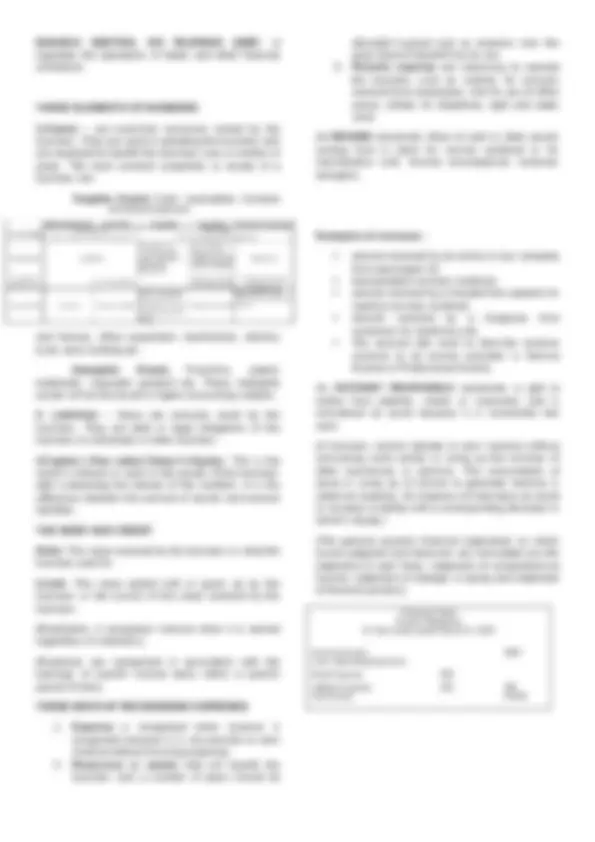
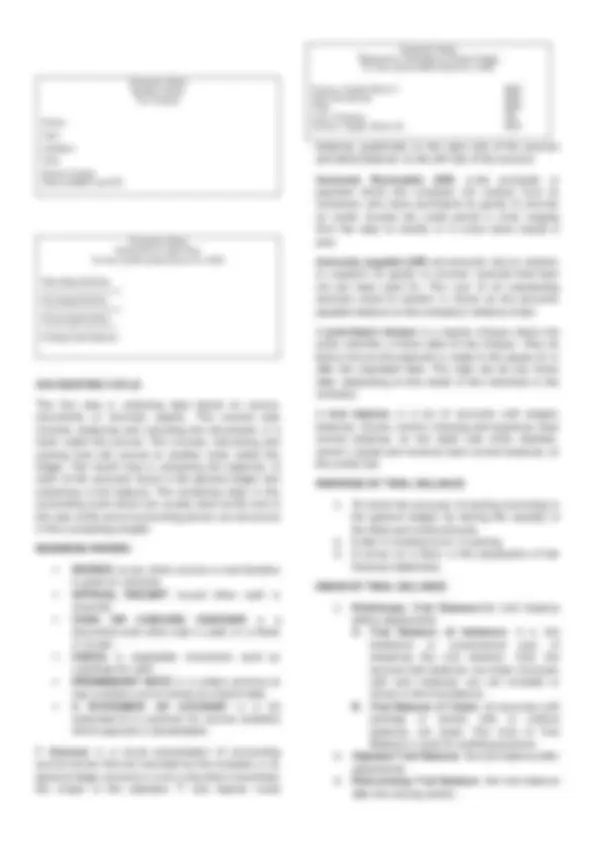
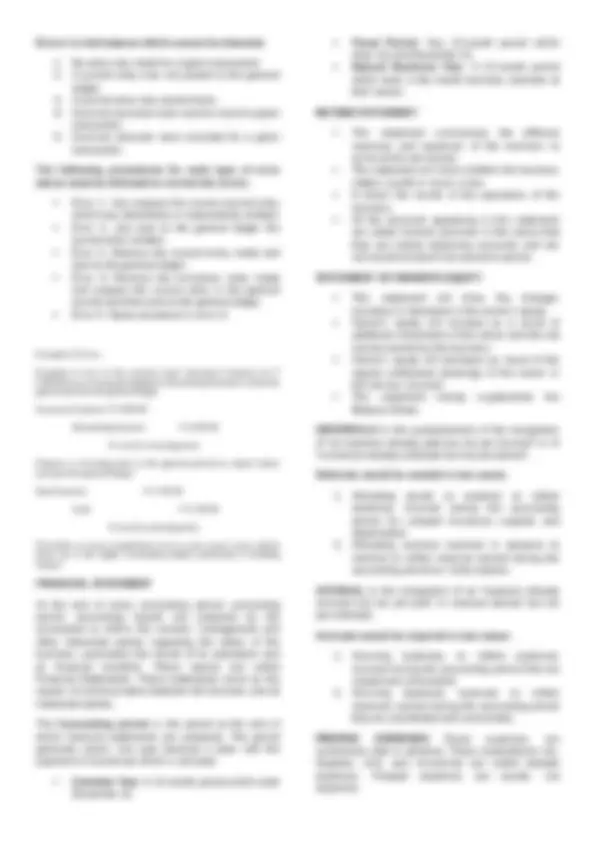
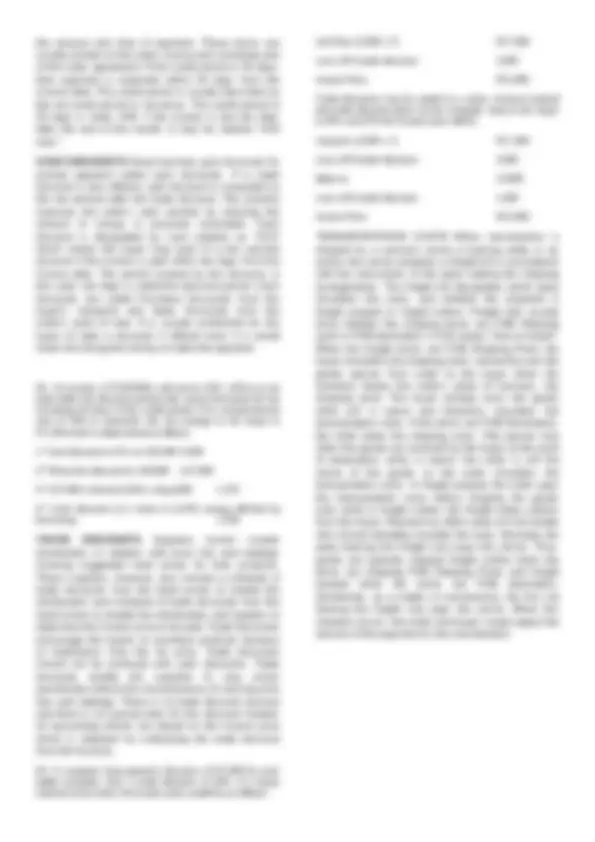
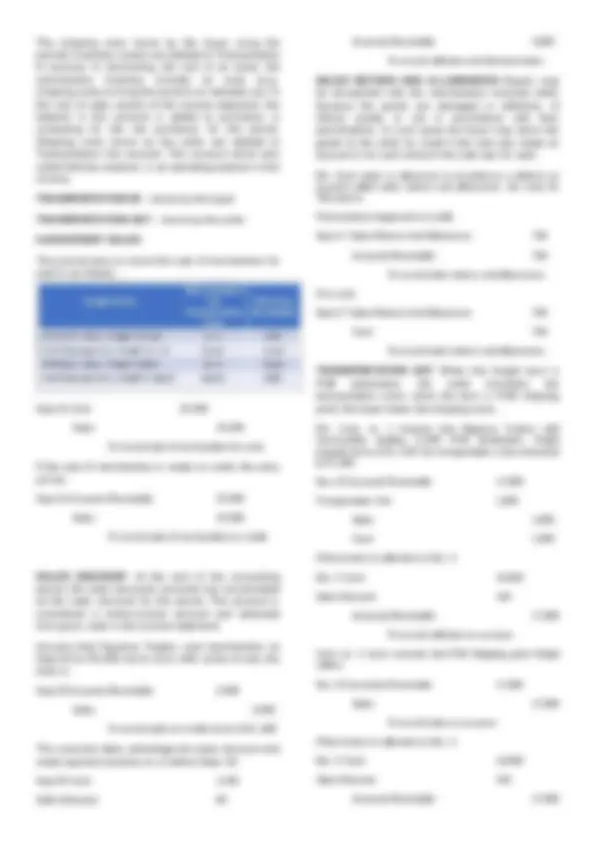
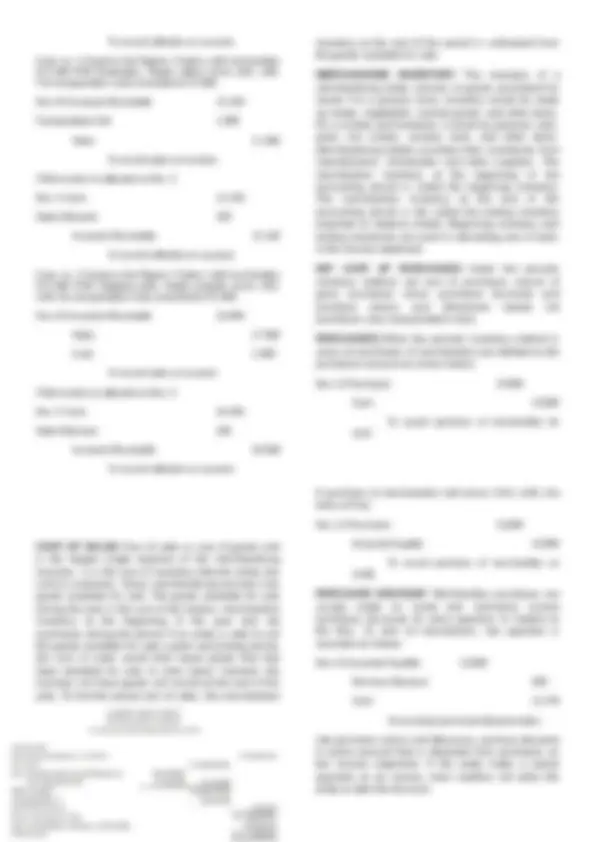


Study with the several resources on Docsity

Earn points by helping other students or get them with a premium plan


Prepare for your exams
Study with the several resources on Docsity

Earn points to download
Earn points by helping other students or get them with a premium plan
Community
Ask the community for help and clear up your study doubts
Discover the best universities in your country according to Docsity users
Free resources
Download our free guides on studying techniques, anxiety management strategies, and thesis advice from Docsity tutors
its all about basic accounting 1 and its brief explanation
Typology: Summaries
1 / 11

This page cannot be seen from the preview
Don't miss anything!







ACCOUNTING is the process of recording financial transactions pertaining to a business. The accounting process includes summarizing, analyzing, and reporting these transactions to oversight agencies, regulators, and tax collection entities. Moreover, accounting is a significant manner and terms of money, transactions and events in which are in part atleast of financial character and interpreting the result thereof. It is also a language of business. When we say BUSINESS , it is regulatory, profit-oriented, and coming together with common sense. Business also define as economic activity of buying and selling in order to obtain profit. (Profit is obtained when the amount you receive if more than the amount you paid for goods and services you sold) (All business need a financial information before making decision) HISTORY OF ACCOUNTING 14 th^ – 17th^ century (renaissance period) Fra Luca Pacioli – Father of Accounting Italy, Europe (debere-debit, credere-credit) OBJECTIVES OF ACCOUNTING Providing information to the usersfor rational decision-making. Systematic recording of transaction. Ascertainment of results of above transaction. Ascertain the financial position of the business. To know the balance sheet. WAYS OF OBTAINING PROFIT In service business – money is received for the cost of service rendered. In merchandising business – money is received for the cost of merchandise given In manufacturing business – money is received for the cost of the product given. TYPES OF BUSINESS ACTIVITIES FINANCING ACTIVITIES -- owner “finances” the business with a capital in cash and other resources. INVESTING ACTIVITIES -- involve the acquisition of properties such as land, furniture, machineries and equipment. OPERATING ACTIVITIES -- day to day activities related to earning of income when goods or services are sold and the incurring of expenses when wages, rent, utilities, transportation are paid.
Auditing – deals with the independent verification and examination of the accounting records for the purpose of giving credibility to the financial statements. Government or Non-Profit Accounting uses “Fund Accounting” which deals with the administration or use of public community funds to bring about service to the people. Tax Accounting – deals with tax matters affecting firms. It involves preparation of tax returns, interpretations and application of tax rules in the determination of tax liability, analyzing tax effect on firm’s or individual’s projects or plans. Forensic Accounting – is getting to be recognized as a new discipline which integrates accounting, auditing and investigative skills. The fraud examiner or forensic accountant works closely with lawyers and helps in solving fraud which could be tracked down by reviewing financial records, papers and electronic trails. GENERALLY ACCEPTED ACCOUNTING PRINCIPLES (GAAP), CONCEPTS & ASSUMPTIONS Generally Accepted Accounting Principles (GAAP )
Company Name Balance Sheet As of (date) Assets Total Liabilities Total Owner’s Equity Total Liabilities and OE Company Name Statement of Cash Flow For the month ended March 31, 2020 Operating Activities ================= Investing Activities ================= Financing Activities ================ Ending Cash Balance ACCOUNTING CYCLE The first step is collecting data based on various documents or business papers. The second step involves analyzing and recording the documents in a book called the journal. The involves classifying and posting from the journal to another book called the ledger. The fourth step is extracting the balances of each of the accounts found in the general ledger and preparing a trial balance. The remaining steps in the accounting cycle which are usually done at the end of the year at the end of accounting period, are discussed in the succeeding chapter. BUSINESS PAPERS INVOICE issues when service or merchandise is given to customer. OFFICIAL RECEIPT issued when cash is received. CASH OR CHECKED VOUCHER is a document used when cash is paid, or a check is issued. CHECK is negotiable instrument used as substitute for cash. PROMISSORY NOTE is a written promise to pay a certain sum of money at a future date. A STATEMENT OF ACCOUNT is a bill presented to a customer for service rendered which payment is demandable. T Account is a visual presentation of accounting journal entries that are recorded by the company in its general ledger account in such a way that it resembles the shape of the alphabet 'T' and depicts credit balances graphically on the right side of the account and debit balances on the left side of the account. Accounts Receivable (AR) is the proceeds or payment which the company will receive from its customers who have purchased its goods & services on credit. Usually the credit period is short ranging from few days to months or in some cases maybe a year. Accounts payable (AP) are amounts due to vendors or suppliers for goods or services received that have not yet been paid for. The sum of all outstanding amounts owed to vendors is shown as the accounts payable balance on the company's balance sheet. A post-dated cheque is a regular cheque where the writer specifies a future date on the cheque. They do that to ensure the payment is made to the payee on or after the stipulated date. This date can be any future date, depending on the needs of the individual or the company. A trial balance is a list of accounts with ledgers balances. Assets, owner’s drawing and expenses have normal balances on the debit side while liabilities, owner’s capital and revenue have normal balances on the credit side. PURPOSE OF TRIAL BALANCE
Errors in trial balance which cannot be detected.
Total Net profit CLOSING ENTRIES these are entries prepared in the general journal at the end of the accounting period (after the financial statements are completed) to close all the nominal accounts preparatory to formally closing the books. This is accomplished by reversing the position of the accounts, i.e accounts with credit balances are debited and accounts with debit balances are credited. EX. Nov. 30 Lawn Cutting Revenues P42,250. Income Summary 42, To record closing of revenue account. CLOSE THE EXPENSE ACCOUNT Expense accounts have debit balances before the closing entries are posted. For this reason, a compound entry is needed crediting each expense account for its balance and debiting the income summary for the total. EX. Income Summary Expense Expense To record closing expense. CLOSE THE INCOME SUMMARY ACCOUNT After posting the closing entries involving the income and expense accounts, the balance of the income summary account will be equal to the profit or loss for the period. A profit is indicated by a credit balance and a loss by a debit balance. The income summary account, regardless of the nature of its balance, must be closed to the capital account. EX. No. 30 Income Summary P17,000. Del Mundo, Capital 17,000. To record the closing of income summary. CLOSE THE WITHDRAWAL ACCOUNT The withdrawal account shows the amount by which capital is reduced during the period by withdrawals of cash or other assets of the business by the owner for personal use. EX. No. 30 Del Mundo, Capital P5,000. Del Mundo, Withdrawals 5,000. To record the closing of drawing account. **TYPES OF INVENTORY SYSTEM
the amount and time of payment. These terms are usually printed on the sales invoice and constitute part of the sales agreement. If the credit period is 30 days, then payment is expected within 30 days from the invoice date. The credit period is usually described as the net credit period or net terms. The credit period of 30 days is notes n/30. if the invoice is due ten days after the end of the month. It may be marked “n/ eom.” CASH DISCOUNTS Some business give discounts for prompt payment called cash discounts. If a trade discount is also offered, cash discount is computed on the net amount after the trade discount. This practice improves the seller’s cash position by reducing the amount of money in accounts receivable. Cash discount is designated by such notation as “2/10” which means the buyer may avail of a two percent discount if the invoice is paid within ten days from the invoice date. The period covered by the discount, in this case- ten days is called the discount period. Cash discounts are called Purchase Discounts from the buyer’s viewpoint and Sales Discounts from the seller’s point of view. It is usually worthwhile for the buyer to take a discount if offered even if it would mean borrowing the money to make the payment. EX. An invoice of P150,000n with terms 2/10, n/30 is to be paid within the discount period with money borrowed for the remaining 20 days of the credit period. If an annual interest rate of 18% is assumed, the net savings to the buyer is P1,530 which is determined as follows: 1 st^ Cash discount of 2% on 150,000 3, 2 nd^ Minus the discount to 150,000 147, 3 rd^ 147,000 x interest (18%) x days/360 1, 4 th^ Cash discount (1st) minus it (1470) saving effected by borrowing 1, TRADE DISCOUNTS Suppliers furnish smaller wholesalers or retailers with price lists and catalogs showing suggested retail prices for their products. These suppliers, however, also include a schedule of trade discounts from the listed prices to enable the wholesalers and schedule of trade discounts from the listed prices to enable the wholesalers and retailers to determine the invoice price to be paid. Trade Discounts encourage the buyers to purchase products because of markdowns from the list price. Trade discounts should not be confused with cash discounts. Trade discounts enable the suppliers to vary prices periodically without the inconvenience of revising price lists and catalogs. There is no trade discount account and there is no special entry for this discount instead, all accounting entries are based on the invoice price which is obtained by subtracting the trade discount from the list price. EX. A computer shop quoted a list price of P2,500 for each tablet computer, less a trade discount of 20%. If a buyer ordered seven units, the invoice price would be as follows: List Price (2,500 x 7) P17, Less: 20% trade discount 3, Invoice Price P14, Trade discounts may be stated in a series. Assume instead that trade discount given by the computer shop to the buyer is 20% and 10% the invoice price will be: List price (2,500 x 7) P17, Less: 20% trade discount 3, Balance 14, Less: 10% trade discount 1, Invoice Price P12, TRANSPORTATION COSTS When merchandise is shipped by a common carrier-a trucking entity or an airline, the carrier prepares a freight bill in accordance with the instructions of the party making the shipping arrangements. The freight bill designates which party shoulders the costs, and whether the shipment is freight prepaid or freight collect. Freight bills usually show whether the shipping terms are FOB Shipping point or FOB destination. F.O.B means “free on board”. When the freight terms are FOB Shipping Point, the buyer shoulders the shipping costs; ownership over the goods passes from seller to the buyer when the inventory leaves the seller’s place of business, the shipping point. The buyer already owns the goods while still in transit and therefore, shoulders the transportation costs. If the terms are FOB Destination, the seller bears the shipping costs. Title passes only when the goods are received by the buyer at the point of destination; while in transit, the seller is still the owner of the goods so the seller shoulders the transportation costs. In freight prepaid, the seller pays the transportation costs before shipping the goods sold; while in freight collect, the freight entity collects from the buyer. Payment by either party will not dictate who should ultimately shoulder the costs. Normally, the party bearing the freight cost pays the carrier. Thus, goods are typically shipped freight collect when the terms are shipping FOB Shipping Point; and freight prepaid when the terms are FOB destination. Sometimes, as a matter of convenience, the firm not bearing the freight cost pays the carrier. When this situation occurs, the seller and buyer simply adjust the amount of the payment for the merchandise.
To record collection on account. Case no. 3 Assume that Figuero Traders sold merchandise P17,000 FOB Destination, freight collect; terms 2/10, n/30. The transportation costs amounted to P1,900. Nov. 25 Accounts Receivable 15, Transportation Out 1, Sales 17, To record sales on account. If this invoice is collected on Dec. 5 Dec. 5 Cash 14, Sales Discount 340 Accounts Receivable 15, To record collection on account. Case no. 4 Assume that Figuero Traders sold merchandise P17,000 FOB Shipping point, freight prepaid; terms 2/10, n/30. the transportation costs amounted to P1,900. Nov. 25 Accounts Receivable 18, Sales 17, Cash 1, To record sales on account. If this invoice is collected on Dec. 5 Dec. 5 Cash 18, Sales Discount 340 Accounts Receivable 18, To record collection on account. COST OF SALES Cost of sales or cost of goods sold is the largest single expense of the merchandising business. it is the cost of inventory that the entity has sold to customers. Every merchandising business has goods available for sale. The goods available for sale during the year is the sum of two factors; merchandise inventory at the beginning of the year and net purchases during the period. If an entity is able to sell the goods available for sale a given accounting period, the cost of sales would then equal goods that had been available for sale. In most cases, however, the business will have goods still unsold at the end of the year. To find the actual cost of sales, the merchandise inventory at the end of the period is subtracted from the goods available for sale. MERCHANDISE INVENTORY The inventory of a merchandising entity consists of goods purchased for resale. For a grocery store, inventory would be made up meats, vegetables, canned goods, and other items. For a lumber and hardware, it would by plywood, nails, paint, iron sheets, cement, tools, and other items. Merchandising entities purchase their inventories from manufacturers, wholesalers and other suppliers. The merchandise inventory at the beginning of the accounting period is called the beginning inventory. The merchandise inventory at the end of the accounting period is the called the ending inventory (reported to balance sheet). Beginning inventory and ending inventories are used in calculating cost of sales in the income statement. NET COST OF PURCHASES Under the periodic inventory method, net cost of purchases consist of gross purchases minus purchases discounts and purchase returns and allowances equals net purchases; plus transportation costs. PURCHASES When the periodic inventory method is used, all purchases of merchandise are debited to the purchases account as shown below: Nov. 12 Purchases 15, Cash 15, To record purchase of merchandise for cash. If purchase of merchandise with terms 2/10, n/30, the entry will be; Nov. 12 Purchases 15, Accounts Payable 15, To record purchase of merchandise on credit. PURCHASE DISCOUNT Merchandise purchases are usually made on credit and commonly involve purchases discounts for early payment. In relation to the Nov. 12 and 14 transactions, the payment is recorded as follows: Nov. 22 Accounts Payable 13, Purchase Discount 260 Cash 12, To record payment and discount taken. Like purchases returns and allowances, purchase discounts is contra account that is deducted from purchases on the income statement. If the entity make a partial payment on an invoice, most creditors will allow the entity to take the discount.
TRANSPORTATION IN Assume that Figueroa Traders made purchases totaling P8,500 FOB destination, freight prepaid; terms 2/10, n/30. transportation costs amounted to P950. The entry would be: Nov. 25 Purchases 8, Accounts Payable 8, If this invoice is paid on Dec. 5 Dec. 5 Accounts Payable 8, Purchase Discount 170 Cash 8, OPERATING EXPENSES Operating expenses make up third major part of the income statement for a merchandising entity. These are expenses, other than the cost of sales, which are incurred to generate profit from the entity’s major lines of business – merchandising. It is customary to group operating expenses into useful categories. Distribution costs, administrative expenses are the categories. Distribution costs or selling expenses are those expenses related directly to the entity’s efforts to generate sales. These includes sales salaries and commissions, and the related employer payroll expenses; advertising and store displays, traveling expenses’ store supplies used; depreciation of store property and equipment, and transportation out VALUE ADDED TAX Previous entries for sales and purchases did not incorporate the effect of value- added taxes on the transactions to simplify the illustration. The illustration below will give you an idea. Extensive discussion of VAT is in another text, Transfer and Business Taxation. EX. On May 13, 2019, Samuel Barbo Feeds purchased on account specialty feeds with a total amount payable of 784,000. A wholesaler bought the feeds on May 25, 2019, amount of cash received was P1,120,000. Samuel Barbo Feeds paid the VAT due by month end not minding the actual deadline. May 13 Purchases (784,000/112%) 700, Input Tax (700,000 x 12%) 84, Accounts Payable 784, Cash 1,120, Sales (1,120,000/112%) 1,000, Output Tax (1,000,000 x 12%) 120, 31 Output Tax 120, Input Tax 84, VAT Payable 36, VAT Payable 36, Cash in Bank 36, Assume that the wholesaler purchased on May 25 and granted with 2/10. On May 30, Barbo was able to collect the account. May 30 Cash (1,120,000-20,000-2,400) 1,097, Output Tax (1,000,000 x 12% x 2%) 2, Sales Discount (1,000,000 x 2%) 20, Accounts Receivable 1,120, The VAT payable is 33,600 ((120,000-2,400)- 84,000). .